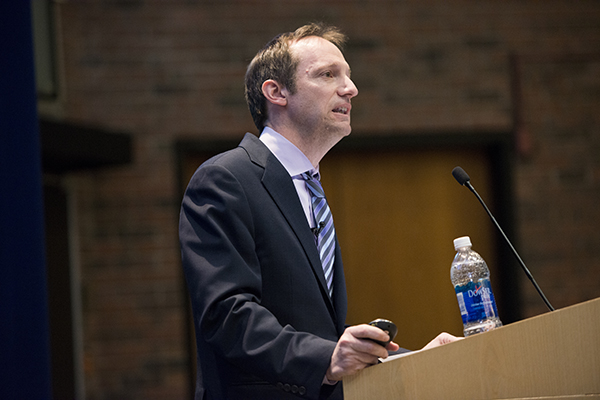

“There’s nothing on TV” is a common phrase among couch surfers, but in this entertainment age, changing the channel is no pressing issue.
On Thursday, March 27, SUNY New Paltz alumnus and Chief Operating Officer of AMC Networks Ed Carroll, as part of the college’s Distinguished Speaker Series, held a lecture on what he referred to as a new “golden age” of television, in which film is being replaced by TV as the medium for thoughtful drama narratives.
Carroll started by providing context on the nature of a “hit show” on television, both in the past and today. According to a slideshow detailing television viewership ratings from various decades, an estimated 52 million American households had televisions (TVHH) in 1964, 19 million of which were tuned to “Bonanza” each night it aired — a statistic that when measured, accounted for 36.5 percent of the total potential market. According to the same slideshow, the soap opera “Dynasty” ranked No. 1 at 25 million of a potential 85 million TVHH in 1984, totaling 29.4 percent of the market.
“Now we’re going to [2004] and we see something different start to happen,” Carroll said. “Although the television homes in the country continue to soar to about 110 million, the number one show, ‘CSI,’ is watched by 18 million and it falls pretty quickly after that — the audience is getting fragmented.”
Carroll attributed the fragmentation phenomenon to the growing range of television and other media options. According to him, in 1990 the average number of television channels was 33 compared to 2013’s 189 channels. Alongside that is YouTube, which receives 168 million views per month and Netflix, which averages 4 million streams per month and accounts for 50 percent of American broadband usage on any given night.
Despite what seems to be audiences’ move away from TV, Carroll said television still counts as the primary medium for content consumption — 35 hours per week of an average American’s 60 hours of content consumption per week.
This confluence of competing media outlets resulting from technological advancements and its derivative, audience fragmentation, has created a rush for quality television “almost by accident,” according to Carroll.
“For half a century, television defined itself as a mass media,” Carroll said. “So if you were a [television] programmer, you wanted a show that was L.O.P. — the Least Objectional Programming.”
Carroll explained that in a time where only three to four television options existed, networks would air conventionally safe, conservative programming to appeal to the largest viewing audience. However, in the age of audience fragmentation, networks now have the leeway to take risks in airing “edgier” content — attracting niche audiences that in the past would not have had the viewership necessary to be considered economically viable.
Carroll cited HBO’s “Girls” as a prime example of a hit-show based on its “committed, passionate audience,” that, despite having a viewership of less than 500,000 in today’s market of 115 million TVHH, is what cable networks desire.
Carroll said this approach at niche, quality programming is the direction he took as AMC’s President of Entertainment Services when in 2007 the network, whose channel programming was exclusively movies, sought to create original content when their function was challenged by commercial-free video on demand services.
“I told our production people, ‘do not worry about ratings, just worry about something that’s fresh, something that’s not been done before,’” Carroll said.
It was at that point, Matthew Weiner, a writer of HBO’s then recently-concluded mafia drama, “The Sopranos” approached AMC with the pitch that would become “Mad Men.” The show had been passed up by networks such as HBO and Showtime for worries Carroll said had to do with its nature as a period piece as well as the belief that audiences would be uninterested in its ad agency setting. Though sharing similar worries, AMC picked up the show, seeing it as fresh and shot the pilot for about $5 million.
According to Carroll, “Mad Men” premiered to about 700,000 people, only half of whom were in the 25 to 54 demographic that advertisers buy into.
“The buzz started to build, the press embraced it, it started to show up in fashion magazines and it built and it built and it built,” Carroll said. “Audiences were able to come on and discover the show and that’s why ‘Mad Men’ is where it is.”
A year and a half later, Vince Gilligan, a writer previously of “The X-Files” came to AMC with a pitch about “a chemistry teacher who got a bad diagnosis and he would decide to resort to making and selling crystal meth,” as Carroll explained. Since then, many networks have moved into the space of higher-end dramas.
“They get an upscale discerning audience, they stand out, get attention and if advertisers like it, they’ll pay a premium,” Carroll said. “Networks, now more than ever can be rewarded for taking a chance — breaking old formulas, trying something new, creating complex characters doing morally ambiguous things. At least for me, television has replaced movies at telling intricate stories and pushing boundaries.”
According to Carroll, part of the economics of airing high-end drama is to dissuade audiences from “binge-viewing” series on Netflix or elsewhere after they premiere live since advertisement dollars are what directly fund television networks.
The solution to this problem, he said, is to challenge writers to remain fresh and unpredictable — thus ensuring return viewers week after week.
“We want to shock the audience; we want to penalize them for not watching,” Carroll said. “If you don’t watch ‘The Walking Dead’ on Sunday and you go to work on Monday, guess what, you may learn that your favorite character was just killed off. That’s the penalty for you.”
